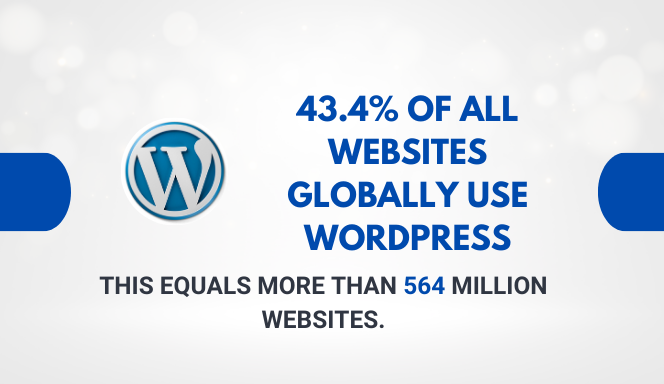
Digital Marketing Strategist & Web Designer helping creatives and agencies build profitable online businesses with Elementor & WordPress.
26/09/2025

How many websites use WordPress is a common question for anyone curious about the web today. WordPress is not just a blogging tool anymore—it powers blogs, business sites, online stores, and even enterprise platforms, and as of today, you can use it to build powerful SaaS projects. Knowing how many websites use WordPress helps us understand its role in shaping the internet and why it remains the most popular content management system (CMS).
As of September 2025, 43.4% of all websites globally use WordPress. This equals more than 564 million websites. When looking only at sites that use a CMS, WordPress holds an even larger 60.8% market share, showing its clear dominance in the CMS space.
When we ask how many websites use WordPress, the answer depends on how the data is measured. Not every website is active, and not every website uses a content management system (CMS). Some are static pages, while others run on custom-built platforms.
To get accurate numbers, most statistics come from trusted industry trackers such as W3Techs and Netcraft. These organizations scan millions of domains and identify which technologies each site is using. The reports then calculate two main figures:
These two perspectives matter. Looking at all websites shows WordPress’ place in the wider internet, while CMS-only data highlights its dominance among platforms people actively choose to manage content.
WordPress continues to lead the web in 2025. The latest data shows that:
These numbers confirm that WordPress is still the most widely used platform for building websites. Whether it’s a personal blog, a business site, or an online store, WordPress powers more than four out of every ten sites you visit online.
WordPress has grown steadily since its launch in 2003. What started as a simple blogging tool is now the leading CMS on the web.
This steady rise shows how WordPress has expanded from blogs into business websites, online stores, portfolios, and enterprise platforms. The growth also reflects the strength of its open-source community, wide plugin ecosystem, and ease of use compared to other CMS options.
While WordPress leads the market, other CMS platforms also hold notable shares. The latest figures show:
Compared to these platforms, WordPress remains far ahead. Its market share of 60.8% among CMS websites highlights how dominant it is. The wide range of themes, plugins, and community support makes WordPress the first choice for many site owners, from small blogs to enterprise websites.
The size of the WordPress ecosystem is one of the main reasons for its popularity. Users have access to a huge library of themes, plugins, and tools that extend what the platform can do.
This scale makes WordPress flexible for almost any type of website. From simple blogs to complex e-commerce stores, the ecosystem provides ready solutions without needing custom development.
E-commerce is one of the strongest areas for WordPress, thanks to WooCommerce, its most popular plugin.
WooCommerce turns a WordPress site into a full online store with product pages, carts, checkout, and payment options. Its popularity comes from being free to start, easy to set up, and supported by thousands of add-ons for shipping, marketing, and payment gateways.
WordPress is used across the world, but adoption varies by region and industry.
These patterns show how WordPress adapts to different needs, from local businesses to global enterprises.
The usage numbers show why WordPress remains the first choice for building websites. Its wide adoption means:
For anyone planning a new website, these points make WordPress a reliable and future-ready option.
WordPress offers a large variety of themes and plugins, both in its official directories and from third-party providers.
These tools make it possible to create almost any type of website—blogs, portfolios, business sites, or online stores—without coding.
WordPress continues to dominate the web, powering 43.4% of all websites and 60.8% of CMS-based sites. Its growth over the years shows its adaptability for blogs, business sites, and e-commerce platforms. The large ecosystem of themes and plugins, combined with global adoption across industries, makes WordPress a reliable choice for anyone building a website.
Whether you are a beginner, business owner, or developer, WordPress provides the tools and support to create a professional site quickly and efficiently.
References
Netcraft – Web server survey and hosting trends: https://news.netcraft.com/
With All Access, you unlock everything you need to build, scale, and stand out. Get complete reusable AI prompts designed for high-quality results across any niche, and unlimited premium Elementor templates to create stunning websites without restrictions. One subscription gives you unlimited growth and the tools to bring your vision to life.